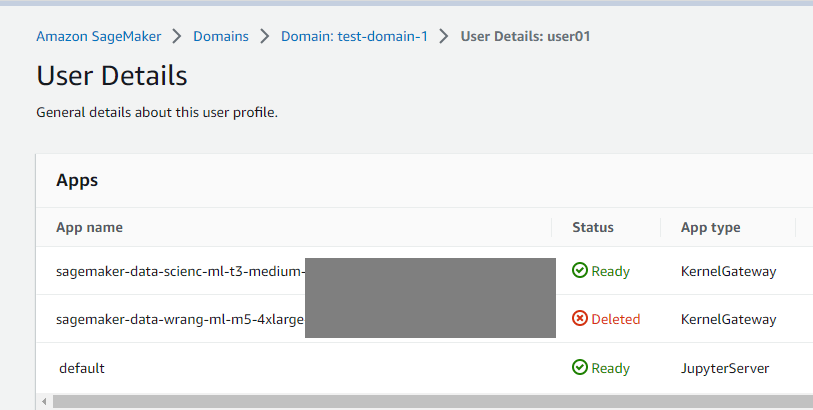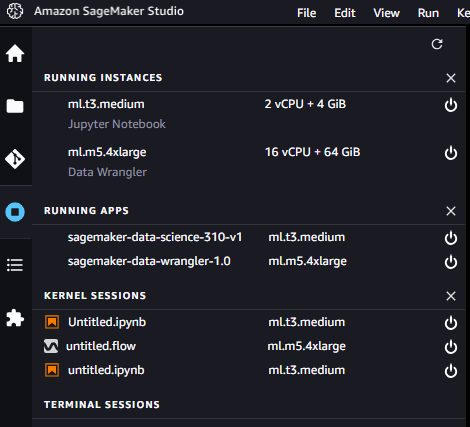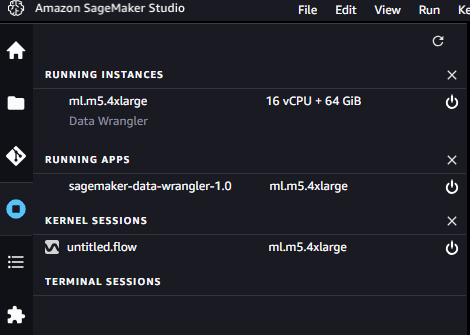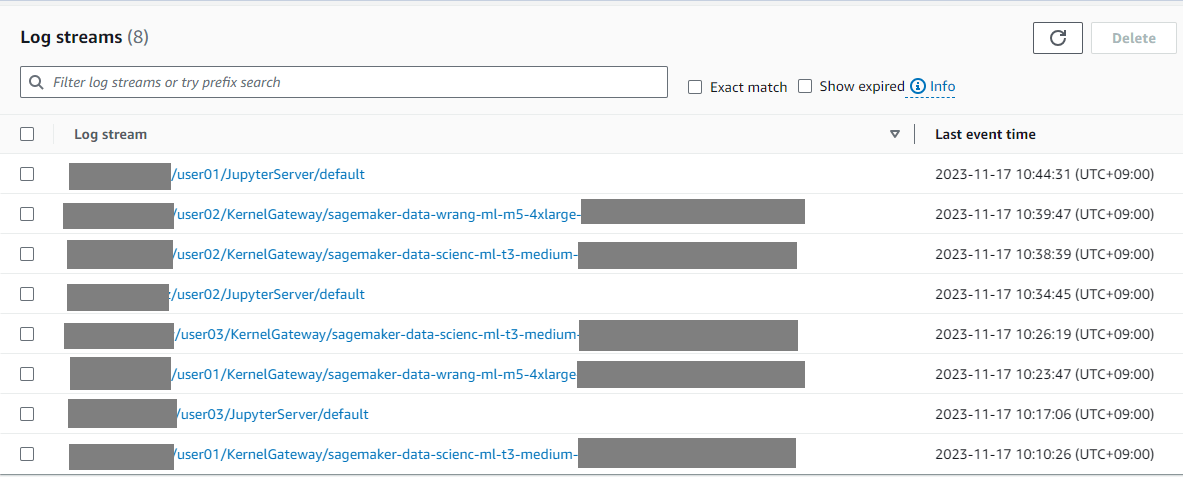Amazon SageMaker Studioでリソースの消し忘れを検知する


はじめに
ご覧いただきありがとうございます。阿河です。
Amazon SageMaker Studioは様々なMLOPS機能を提供していますが、様々なリソースを立てているうちにリソースを消し忘れて思わぬ課金が発生することがあります(私もありました)
特にAmazon SageMaker Data Wranglerは便利な反面、時間あたりの料金がかかるので、リソースの消し忘れをするとお財布に響きます。
IDLE状態のリソースがあった場合、(自動シャットダウンでなく)管理者やユーザーがリソースの消し忘れを確認できるようにしました。
概要
- 料金について
- 想定環境
- Lambda関数の作成
- 実行結果
1. 料金について
発生するコストはインスタンスタイプに基づいており、インスタンスごとに個別に請求されます。
課金は、インスタンスの作成時に開始され、インスタンス上のすべてのアプリケーションが
シャットダウンされるか、インスタンスがシャットダウンされたときに停止します。
インスタンス上で実行されているノートブックをシャットダウンしても、
インスタンスをシャットダウンしなければ、課金は継続します。
複数のノートブックを異なるカーネルで起動したとしても、
同じインスタンスタイプである限り、ノートブックは同じインスタンス上で実行されます。
複数のノートブックが開いていたとしても、実行中のインスタンスが 1 台の場合は、
その 1 台のインスタンスの起動時間に対してのみ課金されます。
ノートブックをシャットダウンすると、ノートブック自体は削除されませんが、
未保存のデータが失われます。
料金については、上記のページが分かりやすいと思います。
今回はカーネルゲートウェイアプリケーションと、SageMaker Data Wrangler リソースをテスト対象としています。
2. 想定環境
■ Domain

- 複数ドメインが同リージョンに存在している環境を想定しています。今回はテストとして2つのドメインをバージニア北部リージョンに作成しています。
■ UserProfile

- test-domain-1には、2つのユーザープロファイルが存在します。

- test-domain-2には、1つのユーザープロファイルが存在します。
■ Resource
- それぞれのユーザープロファイルがカーネルゲートウェイアプリケーションとData Wanglerリソースをそれぞれ立ち上げて、処理を実行します。

- test-domain-1に属するuser01は、Data Wrangler用のリソースをシャットダウンしたものの、カーネルゲートウェイアプリケーションを起動したまま放置。

- test-domain-1に属するuser02は、カーネルゲートウェイアプリケーションをシャットダウンしたものの、Data Wrangler用のリソースを起動したまま放置。
※インスタンスのシャットダウンについて

- インスタンスを削除するには、アプリケーションを削除する必要がある。

- カーネルゲートウェイアプリケーションを削除すると、ml.t3.mediumのインスタンスが同時にシャットダウンしました。
■ Lambda
- 今回はドメインごとにLambda関数を用意します。
- test-domain-1用のLambda関数を実行して、リソースを長時間IDLE状態にしたままのユーザーを特定します。
- 今回の場合はtest-domain-1ドメインに所属するユーザー(user01/user02)2名がリソースを消し忘れているため、2名のユーザー名をLambda関数で取得できればよいです。
■ CloudWatch Logs

-
/aws/sagemaker/studioのロググループを確認します。
-
カーネルゲートウェイ/Data Wranglerリソースどちらも、同じアプリケーションタイプとして、ログストリームが作られています。
[domain-id]/[user-profile-name]/[app-type]/[app-name]
- 上記のログストリーム名で、「どのドメインか」「どのユーザープロファイルか」「アプリケーションタイプ」「アプリケーション名」を識別できます。
3. Lambda関数の作成
※設定
Runtime: Python 3.11
Architecture: x86_64
Lambda関数にアタッチするIAMロールは、「CloudWatch Logs」「SageMaker」の権限を適宜追加してください。
※コード
※Parameterセクションの3つのパラメータは、環境に合わせて変更してください。
import boto3
from datetime import datetime, timezone, timedelta
jst = timezone(timedelta(hours=9), 'JST')
# Parameter
threshold = 86400 #tolerable time for idle state
target_region = "us-east-1" #region
domain_id = "xxxxxxxxxxxx" #domain id
def list_target_user_profile(specified_domain_id, client):
profiles = []
# Check the UserProfile Name corresponding to the specified domain name and store it in the list
for profile in client.list_user_profiles(DomainIdEquals = specified_domain_id)['UserProfiles']:
name = profile['UserProfileName']
profiles.append(name)
return profiles
def list_target_app(userProfiles, client):
apps = []
# Check Apps per UserProfile and store in list
# Only when the application type is kernelGateway and the status is Inservice, it is the target of storage.
for i in userProfiles:
user = i
for n in client.list_apps(UserProfileNameEquals = i)['Apps']:
if len(n) > 0 and n['AppType'] == 'KernelGateway' and n['Status'] == 'InService':
user = n['UserProfileName']
app = n['AppName']
dict= {}
dict[user] = app
apps.append(dict)
return apps
def search_idle_instace(apps, client):
target_user = []
# Compare current time and log update date
# If the difference is greater than or equal to the threshold, store in the list
for i in apps:
for d in i:
response = client.describe_log_streams(
logGroupName='/aws/sagemaker/studio',
logStreamNamePrefix = f'{domain_id}/{d}/KernelGateway/{i[d]}',
descending=True,
limit = 1
)
modified_time = response['logStreams'][0]['lastEventTimestamp']
time = datetime.fromtimestamp(modified_time/1000, jst)
print(time)
dt = datetime.now(jst)
print(dt)
diff = dt - time
print(diff)
d_diff = diff.days * 86400
sum_diff = d_diff + diff.seconds
message = f"user_name:{d}, diff:{sum_diff}\n"
print(message)
if sum_diff > threshold and d not in target_user:
target_user.append(d)
return target_user
def lambda_handler(event, context):
user_profiles = []
sm_client = boto3.client("sagemaker", target_region)
cw_logs_client = boto3.client('logs', target_region)
# Stores the names of UserProfiles belonging to the domain
user_profiles = list_target_user_profile(domain_id, sm_client)
print(user_profiles)
# Define the correspondence between UserProfiles and running applications
apps = list_target_app(user_profiles, sm_client)
print(apps)
# Check the application log to see which applications are in idle status
target_user = search_idle_instace(apps, cw_logs_client)
print(target_user)
4. 実行結果
Lambda関数を実行します。
24時間(86400秒)経過以降に実行しています。
# result(list_target_user_profile)
['user02', 'user01']
# result(list_target_app)
[{'user02': 'sagemaker-data-wrang-ml-m5-4xlarge-xxxxxxxxxxxxxxxxxxxxxxxx'}, {'user01': 'sagemaker-data-scienc-ml-t3-medium-xxxxxxxxxxxxxxxxxxxxxxxxx'}]
# result(search_idle_instace)
2023-11-17 11:04:42.316000+09:00
2023-11-18 12:25:04.657602+09:00
1 day, 1:20:22.341602
user_name:user02, diff:91222
2023-11-17 10:25:06.861000+09:00
2023-11-18 12:25:04.689970+09:00
1 day, 1:59:57.828970
user_name:user01, diff:93597
# target_user list
['user02', 'user01']
- test-use-1に所属しており、かつIDLE状態のリソースを持つユーザーの名前が取得できています。
さいごに
今回用意したLambdaをEventBridge + SNSと連携させて日常的に定期実行させれば、管理者やユーザーがリソースの消し忘れについて確認することができます。色々アレンジしてみて下さい。
誰かの参考になれば幸いです。
ここまで読んでいただき、ありがとうございました!
Discussion